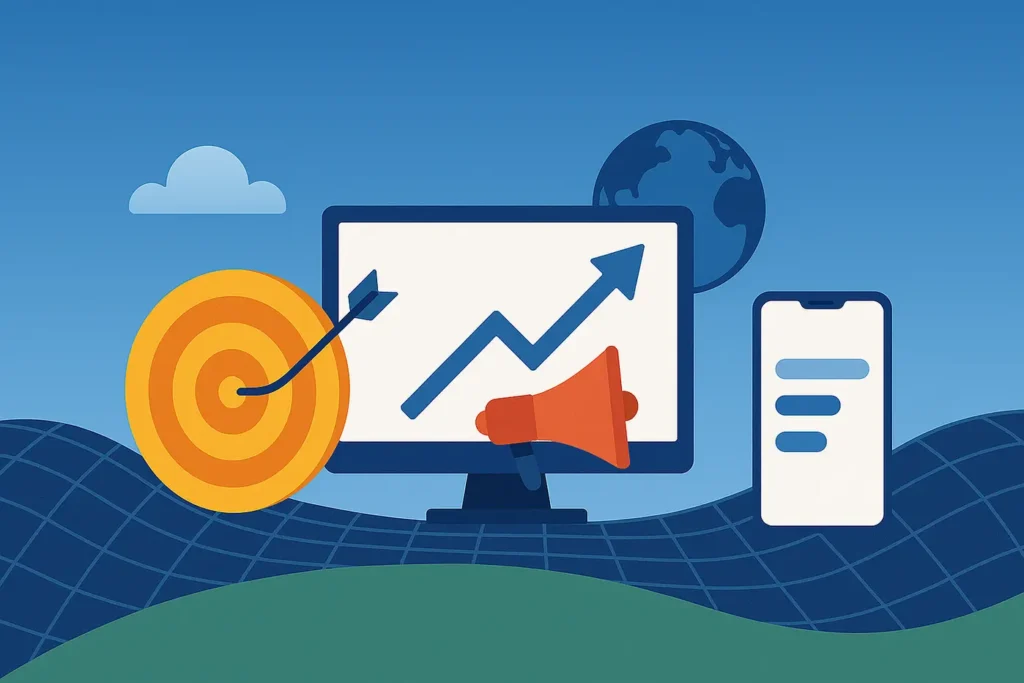Have you ever wondered how a tiny “mom-and-pop” shop managed to triple its email list and double its sales without spending a fortune? It all boils down to the right insights, consistent action, and a bit of creativity. Small and medium businesses face the same headaches: low visibility online, sporadic lead flow, and the nagging question—”Is my marketing even working?” In this guide, we tackle these challenges head-on with real-life stories, simple templates, and tools you can start using today. Read on for budget-friendly ROI tactics, how to run a one-person marketing show like a pro, the outsourcing sweet spot, and the biggest trends shaping SMB marketing this year.
1. Beyond Budget – Maximizing Your Digital Marketing ROI on a Shoestring

Every dollar counts when you’re a small business owner. To make your marketing dollars work harder, focus on measurable activities and channels that deliver the highest return:
Why ROI Matters More Than Ever for SMBs
Measuring ROI helps you allocate resources wisely, justify spend to stakeholders, and continuously improve. Without it, you’re essentially throwing darts blindfolded.
The 3 Key Metrics Every Small Business Should Track
- Customer Acquisition Cost (CAC): Divide total marketing spend by the number of new customers to see how efficiently you acquire business.
- Lifetime Value (LTV): Estimate the total revenue generated by a customer over their relationship with your brand—critical for sustainable growth.
- Return on Ad Spend (ROAS): Compare revenue from specific campaigns against ad costs to identify your most profitable channels.
Low‑Cost Channels with High Impact
- Organic Social Media: Share educational posts, customer stories, and behind-the-scenes content to build community trust—zero ad spend required.
- Email Marketing: Leverage existing customer lists with drip campaigns that nurture leads and drive repeat business.
- Micro‑Influencers: Partner with niche influencers who charge modest fees but deliver high engagement and authentic recommendations.
2. Building Your Dream Team (Even if It’s Just You)

Wearing all the marketing hats can feel overwhelming, but a structured approach will help you scale efficiently—even as a solo operator:
Structuring Your Marketing Department on Day One
Identify the four core roles: strategy, content creation, distribution, and analysis. Even if one person fills all roles, clarity around responsibilities prevents tasks from slipping through the cracks.
The One‑Person Marketing Team Playbook
- Planning (20%): Block time each week to set goals, choose priority channels, and plan campaigns.
- Execution (60%): Batch-create content—write all blog posts, record videos, and design graphics in concentrated sprints.
- Optimization (20%): Review performance metrics weekly to refine messaging, timing, and channel mix.
When & Whom to Hire: Part‑time, Freelancers, or Agencies?
- Part‑time Staff: Great for ongoing tasks like social community management or email scheduling.
- Freelancers: Perfect for specialized, one-off projects—think website designs, complex ad campaigns, or video editing.
- Agencies: Best when you need end-to-end support and access to advanced tools (SEO audits, paid ad management).
3. The DIY Trap – When to Outsource Your Marketing

DIY marketing can save money initially but often leads to subpar results and wasted time. Recognize when outsourcing adds value:
Common DIY Pitfalls That Cost Time & Money
- Inconsistent Quality: Amateur designs or ad campaigns can damage brand perception.
- Scope Creep: Without clear boundaries, you may spend hours on tasks outside your expertise.
- Tool Overload: Subscribing to multiple platforms without proper setup or usage eats into your budget.
Identifying Tasks to Keep In‑House vs. Outsource
- In‑House: Core strategy, brand voice, and high-level oversight—tasks that require intimate knowledge of your business vision.
- Outsource: Technical SEO audits, paid advertising management, advanced analytics, and high-end creative work.
How to Vet & Onboard a Digital Agency
- Define Objectives & Budget: Articulate specific goals—e.g., increase MQLs by 20%—and a realistic spend range.
- Review Case Studies & References: Look for success stories in your industry or with similar budgets.
- Pilot Project: Start small (e.g., a single ad campaign) to test performance and communication style.
- Set Communication Cadence: Agree on weekly or bi-weekly check-ins, KPIs, and reporting formats.
Checklist: Prepare a one-page brief with goals, target audience, and key messages before agency outreach to streamline proposals.
4. Consistency Is King – Creating a Sustainable Marketing Calendar

A consistent publishing cadence builds audience trust and fuels algorithmic preference on platforms:
Why Consistency Beats Intensity
Regular touchpoints keep your brand top of mind and allow for steady data collection—intense one-off pushes often see a quick spike and then a rapid drop-off.
Building & Filling Your Content Calendar Template
- Audit Existing Assets: Identify top-performing blogs, emails, and social posts for repurposing.
- Plan Themes & Campaigns: Align content with product launches, seasonal events, and industry milestones.
- Allocate Channels & Formats: Assign topics to blog posts, newsletters, videos, or social posts based on audience preferences.
Tools & Workflows for Staying on Track
- Editorial Tools: Trello, Asana, or Notion kanban boards to visualize deadlines and statuses.
- Automation Platforms: Buffer, Hootsuite, or Later for scheduled social publishing.
- Review Cadence: Monthly audit meetings (even solo) to adjust content based on performance data.
5. Decoding Your Digital Dollars – Practical Guide to Measuring ROI

Accurate measurement is the backbone of any digital marketing strategy:
ROI Formula Simplified for SMB Owners
ROI % = (Net Profit from Campaign – Marketing Cost) ÷ Marketing Cost × 100. A positive percentage indicates profitable campaigns; negative means reevaluate.
Tools & Dashboards to Track Key Metrics
- Google Analytics: Create custom dashboards to track goal completions, user flows, and attribution paths.
- CRM-Integrated Analytics: Platforms like HubSpot, Zoho, or Salesforce tie leads to specific campaigns for end-to-end visibility.
- Attribution Models: Test first-touch, last-touch, and multi-touch to understand which channels deserve more budget.
Reporting to Stakeholders: What Actually Matters
- Top-Line Metrics: Monthly revenue growth, new customers acquired, and overall marketing cost.
- Efficiency Indicators: ROAS and CAC vs. LTV ratios reveal profitability and long-term viability.
- Actionable Insights: Highlight successes, failures, and concrete next steps—avoid data dumps without context.
Pro Tip: Use color‑coded dashboards to flag metrics that exceed or fall short of targets for quick stakeholder reviews.
6. Staying Ahead of the Curve – Essential Digital Marketing Trends for 2025 and Beyond

The digital landscape evolves rapidly. Here’s what every SMB should prepare for:
Top 5 Trends Shaping SMB Marketing in 2025
- AI-Driven Personalization & Automation: From chatbots to dynamic email content, AI tools allow SMBs to deliver tailored experiences at scale.
- Interactive & Short-Form Video Content: Bite-sized videos on TikTok and Reels drive engagement—use templates and user-generated content to lower production costs.
- Privacy-First Tracking & Cookieless Strategies: Implement consent-based data collection and invest in server-side tracking to future-proof analytics.
- Voice Search & Conversational Interfaces: Optimize content for natural language queries and integrate chatbots to capture hands‑free searches.
- Social Commerce & Shoppable Content: Leverage in-app checkout features on Instagram and Facebook to reduce purchase friction.
Action Step: Conduct a quarterly technology audit to assess readiness for each trend and prioritize implementation based on your audience’s behavior.
Ready to Take Action? ✨ Download the Enhanced SMB Marketing Toolkit (Free Excel)
Download : SMB Marketing Toolkit
Don’t just read—implement! The Enhanced SMB Marketing Toolkit is your all-in-one Excel workbook designed to help small and medium businesses take control of their digital marketing. Inside, you’ll find five powerful sheets: from a smart Channel Checklist and an 8-week Content Calendar, to dynamic ROI Tracking Dashboards, a visual Outsource Decision Flowchart, and practical Mini-Templates to jumpstart execution. Whether you’re a solopreneur or leading a small team, this toolkit gives you clarity, structure, and momentum.
How to Use It:
- Start with the Channel Checklist to choose the best marketing channels for your business goals.
- Use the Content Calendar to plan out consistent weekly content and track task progress.
- Dive into the ROI Tracker weekly to measure performance and optimize spending.
- Refer to the Outsourcing Flowchart whenever you’re deciding whether to delegate a task.
- Pull from the Mini-Templates to write engaging emails, craft social posts, and launch paid ads with confidence.
